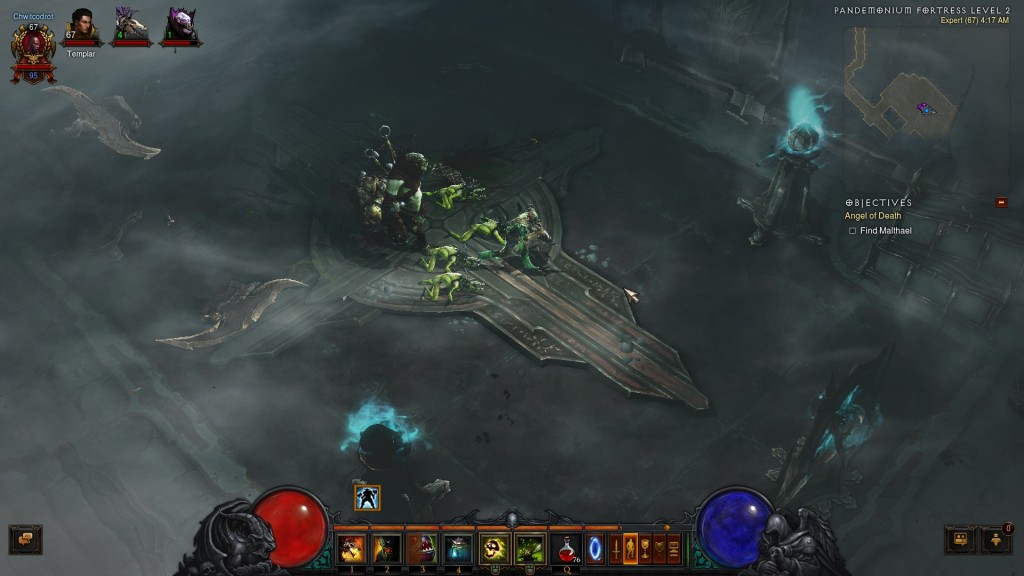The initial release of Diablo III was bumpy. Many felt the game unfinished, and for good reason; had Enemy Slime been around for its release, it would have received a low 3/5. The biggest issues with the core game included a poor itemization system that lead to mostly terrible Legendary items and an overly strong emphasis on simply raising your primary stat, as well as the game’s massive skill imbalances, making choosing skill runes more of a “duh” rather than a tough choice. To boot, the story and characters all sounded like they were taken from a Saturday morning cartoon, often spewing cringe-worthy dialogue complete with lords of Hell who could pass as Power Rangers villains.
Because it’s difficult to say where the recent 2.0 patch ends and Reaper of Souls begins (with the patch incorporating so many important changes), one almost must consider the patch as part of the expansion experience, despite being available for Diablo III classic. The 2.0 changes on the road to Reaper of Souls are quite decent, elevating Diablo III from a barely playable status to something fun and reminiscent of Diablo II. Itemization is largely fixed, meaning there’s a good chance that Legendary items will have secondary affixes attached to them that you can actually create a build around.

Westmarch is under siege by Malthael’s army composed almost entirely of spirits of the mass murdered. Neat.
For example, using Hydra on my Wizard became a no-brainer after finding a wand that not only had decent stats, but also allowed me to have two hydras on the battlefield at once. Similarly, on my Barbarian I found a belt that added such a massive chunk of lightning resistance, with the added secondary ability to constantly fling lightning from being struck, and I felt like rebuilding my Barbarian to use Lightning based skills. This feeling was intensified after finding a sword that often blasts enemies with chain lightning, dealing healthy amounts of damage as if it was a proper spell unto itself.
The news is pretty good then for just the Loot 2.0 patch. You now truly find item drops that can change the entire theme your character is built around, instead of creating a build and then just pumping it full of steroids in the form of your primary stat.
The Reaper of Souls launch went off completely without incident (color everyone surprised). Blizzard accomplished this by patching the expansion content into the game long before the expansion released, thereby requiring only an unlocking mechanism to fire when March 25th came around.
For the uninformed, Reaper of Souls follows immediately after the defeat of Diablo. The angel of death, Malthael has captured the black soulstone, now containing the souls of all the lords of Hell. He hopes to use it as a bargaining chip while he begins the extermination of the entire planet, originating in Westmarch where the majority of Act V takes place. The stakes are high as they typically are in any Diablo game, but it would be a mistake to nail the plot of Reaper of Souls as routine. Malthael first appears to the player as a monstrous figure, but very early on you learn that he is, in his own twisted way, the good guy in his own mind. He is sickened by what he sees on Sanctuary; mortal men betraying each other, not caring for one another, and causing suffering. He decides that the wisest course of action is to end the suffering by exterminating all mortal life and absorbing their souls. This little twisty twist (which isn’t a spoiler as it’s revealed almost immediately) added some welcome depth and thought to the antagonist, far removed from Diablo whose objective was always to simply terrorize the world and overrun Sanctuary with demons.
The fact that the setting is Westmarch, then, is no mistake. The city is home to nobles and peasants alike, and to my surprise there are political things going on. The king must show preference to the nobles to avoid backlash, meanwhile the peasantry have become angry and many are taking advantage of Malthael’s attack to rob the rich. The king decides to take a stand alongside the poor, and there are repercussions. It just adds refreshing detail missing from the base game’s plot.
The dialogue is a touch classier across the board. There were no cringe-worthy moments that I can remember after playing all the way through the expansion. The bosses you fight on the way to Malthael as well as Malthael himself have a darker tone, and don’t go for quite as much needless theatrics or cliche lines. That coupled with the somber violin music that plays in many zones goes a long way to bringing that gothic feel back from Diablo II; it was sorely missing in Diablo III classic with the soft painted art style, cheesy dialogue and overly orchestrated music. Reaper of Souls really delivers on improving the atmosphere.
The two biggest points of the expansion are the Crusader class and Adventure Mode. The Crusader is a surprisingly diverse class capable of long range spell casting as well as melee combat, which utilizes a shield that is supported by numerous passive abilities and spells to raise your block chance. In many ways he mirrors the Paladin from Diablo II by sporting revamped versions of Paladin spells. Fist of the Heavens, Blessed Hammer, Shield Charge, and a few others return. Most of the spells are brand new, though, and even the returning spells have interesting runes to switch up their usefulness.
Aside from the content of an entire new act, the largest addition to the game may be Adventure Mode. Available only after defeating Malthael, Adventure Mode allows you to travel anywhere in the game, even across acts, without the story quests getting in the way. Instead, each act has 5 Bounty quests available and generated randomly each time you quit and re-enter the game. These quests can be simple kill quests, or they can be an objective to complete a side quest that already existed in the game. Completing each one offers a massive experience and gold reward, and doing all the Bounty quests in one act will cause Tyrael to reward you with a cache of about 5-10 random item drops.
Doing Bounty quests also awards Blood Shards which can be gambled; it’s almost identical to gambling in Diablo II. You know the item type you’re buying (for instance you can buy a “1-Handed Weapon”), but you won’t know what it is until it is purchased. This is essentially like paying for a free single drop though, so it’s entirely possible to acquire Legendary items this way. Lastly, you can earn your way into Nephalem Rifts which will take you to strange lands with odd spawning patterns, granting a great experience reward after conquering the boss of the rift. These rifts have their own rules; you’ll be thrust into almost any zone in the game, but with randomized weather and usually monsters from other acts, as well as much higher monster density.
Although the expansion teamed up with patch 2.0 makes great strides to squash Diablo III’s issues, there are a few instances where Blizzard could have gone just a bit further. For instance, all 5 Diablo III classic classes only get one new spell; these spells and abilities are hit and miss, as are the runes that go along with them. All classes get 3 more passives though, which for the most part are worthy of their high level requirement. One of which for the Witch Doctor allows him to summon yet another zombie dog, and increases the damage of dogs and gargantuan by 50%, which clearly shows love being given to players who didn’t feel like playing a minion build made them feel very bad ass.
On the other hand, some spells have gone curiously unbalanced after all this time. Just for example, despite my Witch Doctor having almost twice the damage as my Wizard, my Wizard routinely performs better and kills faster somehow… indeed, this is just lingering unbalance that the Witch Doctor has had to face ever since Diablo III launched, and not every class is as stark a difference.
If Diablo III made you sad and you quit shortly after launch, give it another go with the Loot 2.0 changes. If you feel confident that the changes are headed in the right direction, then go ahead and pick up Reaper of Souls. Although it doesn’t transform Diablo III into a game of the year contender, it humbly offers reparations, smarter dialogue, and solid features in what I feel is an honest attempt to atone for any past wrongdoings.











